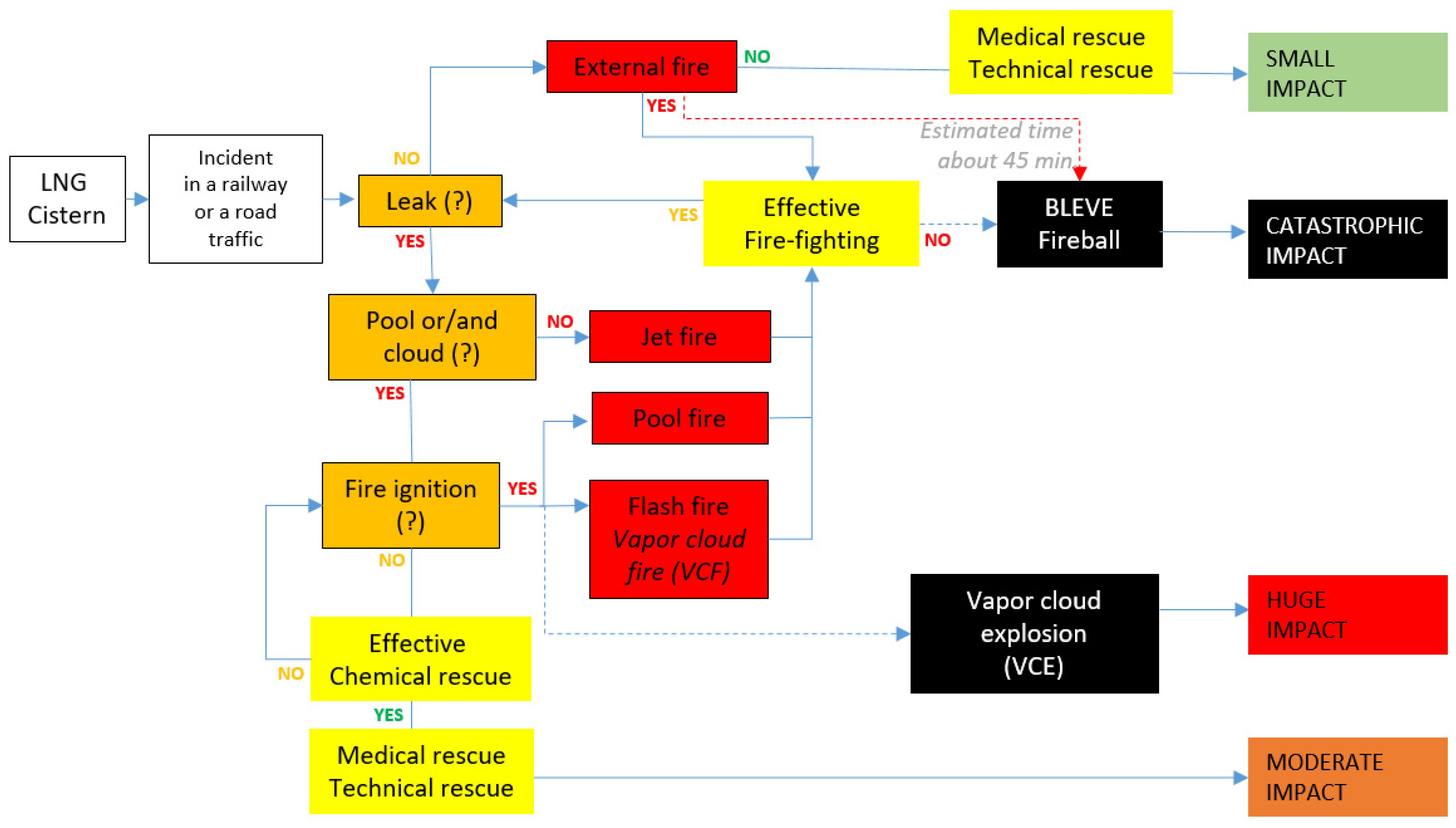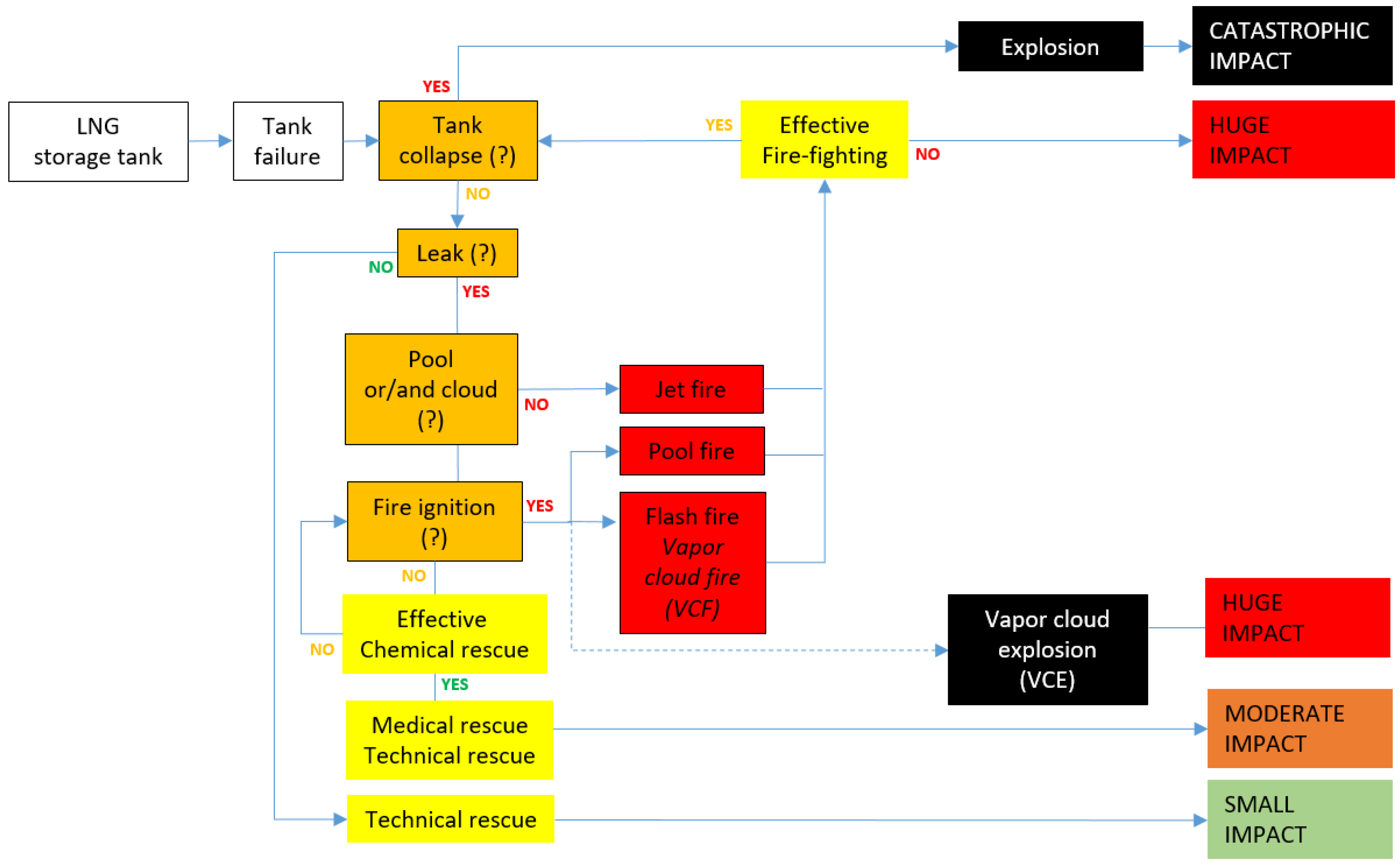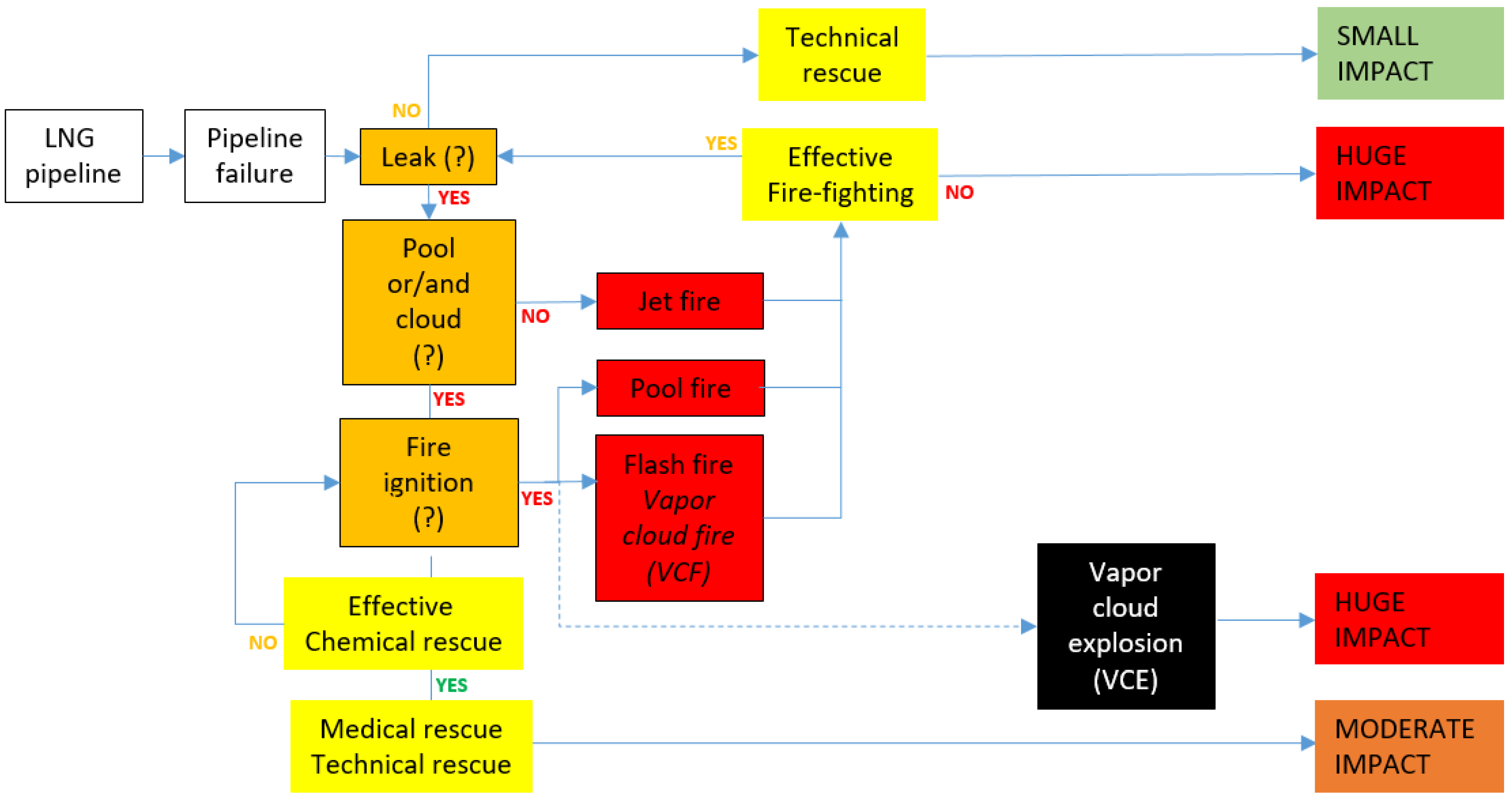
| Version | Summary | Created by | Modification | Content Size | Created at | Operation |
|---|---|---|---|---|---|---|
| 1 | Tomasz Zwęgliński | + 2758 word(s) | 2758 | 2022-03-04 04:46:21 | | | |
| 2 | Jason Zhu | -41 word(s) | 2717 | 2022-03-07 07:32:30 | | |
Video Upload Options
Liquefied natural gas (LNG) is stored in facilities located in urban areas and transported over public roads. A shift towards the broader use of LNG is economically and environmentally justified. Conventional event trees for LNG emergency release in three different units is a concept that is based on the physical and chemical properties of LNG. It has been designed with deep consideration and analysis of past experiences and real cases of LNG incidents. The idea of having training checkpoints, such as ‘decision points’ and ‘learning curve points’ in the continuum of a training or exercise enable the achievement of optimal learning objectives in a flexible way which take into account the trainee individual mental and physical disposition on a day, scalability of difficulty level as well as realistic scenario paths determined by the performance of the trainees facing concrete operational problems.
1. Introduction
-
It is a cheaper source of energy compared to “black products” (petrol and diesel) and liquefied petroleum gas (LPG) [5];
-
It possesses a high energy content; therefore, the total energy needed is reduced [8];
-
It is a “clean fuel” contributing to improved product quality, reducing maintenance costs whilst being more environmentally friendly compared to coal, diesel, petrol or LPG [9];
-
Large amount of natural gas can be stored and transported at low pressures [10].
2. Current Studies



-
The didactic progress of the trainees;
-
Opportunities to improve the training method, including the evaluation method, for further development and improvement of the training/exercising concept.
References
- Murphy, M.J.; Ketola, H.N.; Raj, P.K. Summary Assessment of the Safety, Health Environmental and System Risks of Alternative Fuels; Report No. FTA-MA-90-7007-95-1; Federal Transit Administration, U.S. DOT: Washington, DC, USA, 1995.
- GIIGNL—International Group of Liquefied Natural Gas Importers. The LNG Industry GIIGNL Annual Report 2019; GIIGNL: Neuilly-sur-Seine, France, 2019.
- Klaos, M.; Kriisa, K. Veeldatud maagaasi maanteetranspordi riskid ja paastetoode analuus Kasepaa valla gaasiveoki avarii naitel. Sisekaitseakadeemia toimetised 2010, 9, 33–59, ISSN 1736-8901. Available online: https://www.digar.ee/arhiiv/et/download/198184 (accessed on 25 October 2020).
- Gaz System . Available online: https://www.polskielng.pl/terminal-lng/ (accessed on 23 January 2022).
- Bresciani, G.; Heiligtag, S.; Lambert, P.; Rogers, M. The Future of Liquefied Natural Gas: Opportunities for Growth. McKinsey & Company . Available online: https://www.mckinsey.com/industries/oil-and-gas/our-insights/the-future-of-liquefied-natural-gas-opportunities-for-growth (accessed on 23 January 2022).
- Besedin, S.N.; Dubinkina, A.D. The use of LNG in road transport. Trans. Krylov State Res. Cent. 2021, 1, 345–346.
- Osorio-Tejada, J.; Llera, E.; Scarpellini, S. LNG: An alternative fuel for road freight transport in Europe. Sustain. Dev. 2015, 1, 235–246.
- Zwęgliński, T. Rationalization of emergency response measures for haz-mat incidents involving LNG in road transport. In Internal Security and Public Security. Law and Organization; Verlag Dr. Kovač GMBH Fachverlag fur Wissenschftliche Literatur: Hamburg, Germany, 2020; pp. 137–158. Available online: https://www.researchgate.net/publication/346929806_Rationalization_of_Emergrancy_Response_Measures_for_Hazmat_Incidents_Involving_LNG_in_Road_Transport (accessed on 23 January 2022).
- Lee, H.J.; Yoo, S.H.; Huh, S.Y. Economic benefits of introducing LNG-fuelled ships for imported flour in South Korea. Transp. Res. Part D Transp. Environ. 2020, 78, 102220, ISSN 1361-9209.
- John, A. Alderman. Introduction to LNG Safety. Process. Saf. Prog. 2005, 24, 144–151.
- Joling, D. Tanker truck carrying methane rolls off Parks Highway. Ancorage Daily News. 18 August 2008. Available online: https://www.adn.com/ (accessed on 18 August 2008).
- Thorndike, V.L. LNG: A Level-Headed Look at the Liquefied Natural Gas Controversy; Down East Books: Camden, UK, 2007.
- Vollmacher, K.; Van Esbroeck, T. Accident Involving LNG Truck. Return of Experience; CTIF: Brussels, Belgium, 2018; Available online: https://www.ctif.org/sites/default/files/2018-09/Retex%20LNG%202018%2006%2006%20ENG-reduced%20size.pdf (accessed on 23 January 2022).
- Hansson, J. LNG As an Alternative Energy Supply in Sweden; Report 197; SGC: Lund, Sweden, 2008.
- Er, I.D. Safety and Environmental Concern Analysis for LNG Carriers. Int. J. Mar. Navig. Saf. Sea Transp. 2007, 1, 421–426, ISSN 2083-6473. Available online: https://www.transnav.eu/Article_Safety_and_Environmental_Concern_Er,4,59.html (accessed on 27 January 2021).
- Grossel, S.S. LNG Fire Protection & Emergency Response; Institution of Chemical Engineers—IChemE: Rugby, UK, 2007; ISBN 0852955154.
- Zhang, R.; Jia, J.; Wang, H. Shock Response Analysis of a Large LNG Storage Tank Under Blast Loads. KSCE J. Civ. Eng. 2018, 22, 3419–3429, ISSN 1226-7988.
- Khalid, N.I.M.; Najdi, N.F.N.; Adlee, N.F.K.; Misiran, M.; Sapiri, H. Assessing railway accident risk through event tree analysis. In Proceedings of the AIP Conference Proceedings, Rhodes, Greece, 1–5 May 2019; Volume 2138, p. 030023.
- Planas-Cuchi, E.; Gasulla, N.; Ventosa, A.; Casal, J. Explosion of a road tanker containing liquefied natural gas. J. Loss Prev. Process Ind. 2004, 17, 315–321, ISSN 0950-4230.
- Gorla, R. Probabilistic analysis of a liquefied natural gas storage tank. Appl. Therm. Eng. 2010, 30, 2763–2769.
- Wellman, G.W.; Melof, B.M.; Luketa-Hanlin, A.J.; Hightower, M.M.; Covan, J.M.; Gritzo, L.A.; Irwin, M.J.; Kaneshige, M.J.; Morrow, C.W. Guidance on Risk Analysis and Safety Implications of a Large Liquefied Natural Gas (LNG) Spill over Water; Sandia National Laboratories: Albuquerque, NM, USA, 2004.
- Bralewski, A. Analysis of Threats Involving Liquefied Natural Gas (LNG)—Review of Literature Sources. Saf. Fire Technol. 2019, 54, 32–53.
- Gyenes, Z.; Wood, M.H.; Struckl, M. Handbook of Scenarios for Assessing Major Chemical Accident Risks. Technical Report; Joint Research Centre (JRC), The European Commission: Ispra, Italy, 2017; ISBN 978-92-79-66669-8. Available online: https://publications.jrc.ec.europa.eu/repository/handle/JRC106029 (accessed on 23 January 2022).
- Zwęgliński, T. Distance learning—Comparison of two forms of knowledge transfer—Research results. In Provocari si Strategii in Ordinea si Siguranta Publica; Fire Officers Faculty, Police Academy: Bucarest, Romania, 2014; pp. 52–59. ISBN 978-606-591-972-3. Available online: https://www.editurauniversitara.ro/stiinte-juridice-si-administrative-10/provocari-si-strategii-in-ordinea-si-siguranta-publica.html (accessed on 23 January 2022).
- Zwęgliński, T. Metodologiczne Podstawy Teorii Ewaluacji Ćwiczeń w Zakresie Zarządzania Kryzysowego i Ochrony Ludności. In Racjonalizacja Zarządzania Jednolitymi Formacjami Umundurowanymi Odpowiedzialnymi za Bezpieczeństwo Wewnętrzne—Tom IV; Wydawnictwo Szkoły Głównej Służby Pożarniczej: Warsaw, Poland, 2019; pp. 252–277. Available online: https://bibliotekasgsp.locloudhosting.net/files/original/d3158537accb2679dfc764929efc9ea6.pdf (accessed on 23 January 2022).
- Radkowski, R.; Zwęgliński, T. Organizational Aspects of the Rescue System in Poland. In Security and Law in the Cognitive and Utilitarian Context; Verlag Dr. Kovač GMBH Fachverlag fur Wissenschftliche Literatur: Hamburg, Germany, 2015; pp. 145–158. ISBN 978-3-8300-8717-5.
- Hayward Walker, A. Response Considerations for LNG Spills. In Proceedings of the Interspill Conference, London, UK, 21–23 March 2006; Available online: https://www.researchgate.net/publication/320335739_RESPONSE_CONSIDERATIONS_FOR_LNG_SPILLS (accessed on 23 January 2022).
- Zwęgliński, T.; Brancaleoni, R.; Mijatović, A. Good practices in organization of crisis management exercises in order to build society resilience. Zesz. Stud. Pro Publico Bono 2018, 1, 169–177, ISSN 2544-2481. Available online: https://www.researchgate.net/publication/330321329_Good_Practices_in_Organization_of_Crises_Management_Exercises_in_Order_to_Build_Society_Resilience (accessed on 23 January 2022).




